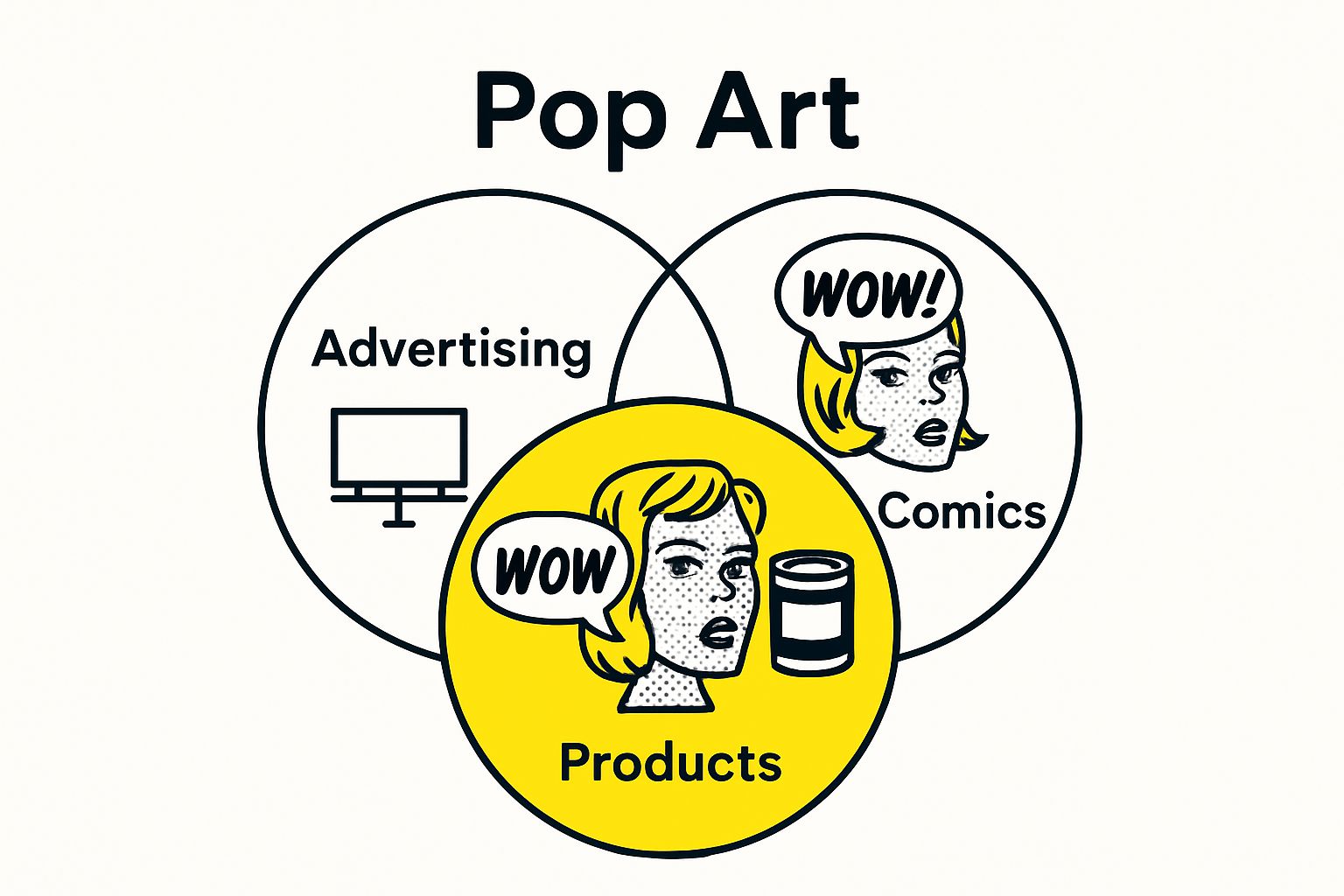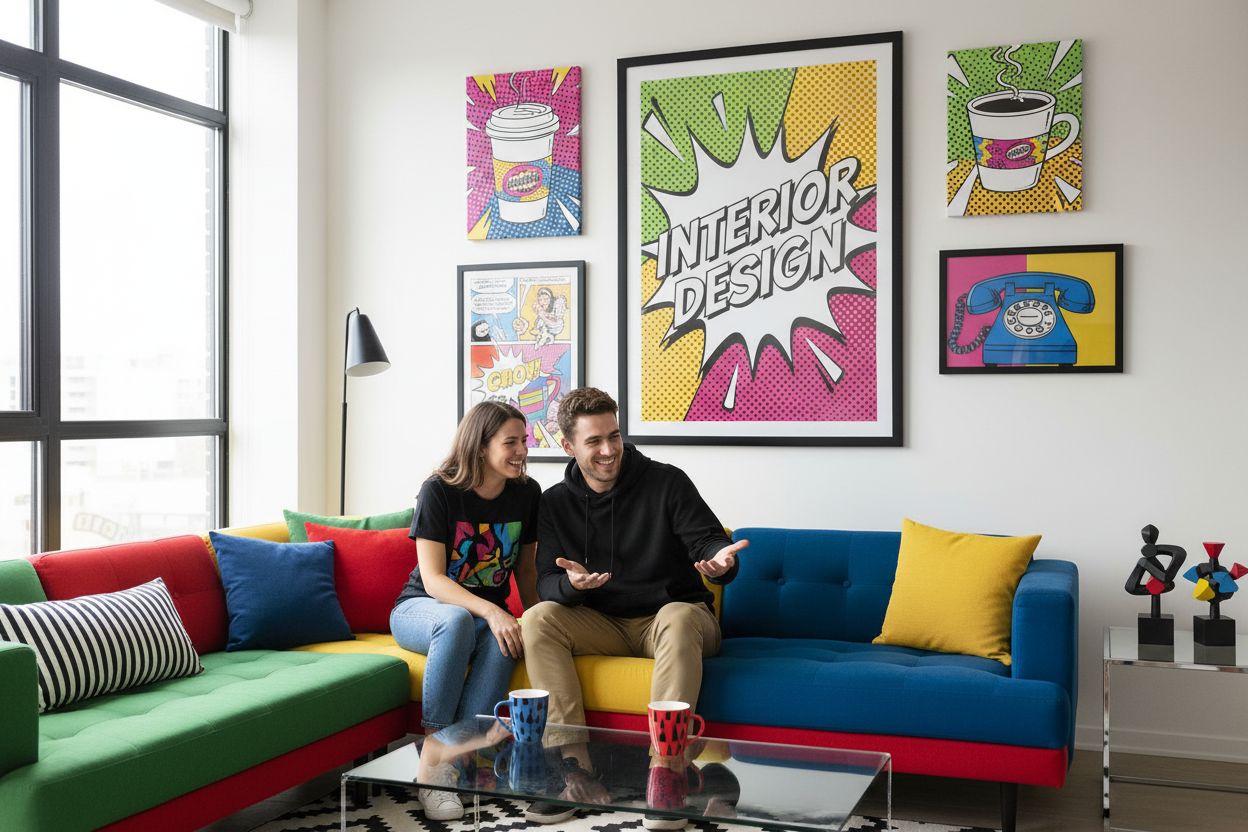Understanding What is Pop Art and Its Impact

Pop art burst onto the scene in the 1950s and turned everyday consumer images into icons. Think comic books, billboards, and branded soup cans. But what might surprise you is just how radical this shift was. Before pop art, fine art was an exclusive club and the movement changed that overnight. It flipped the script, proving that even the most ordinary objects could spark cultural revolutions and shake up the way society saw itself.
Table of Contents
- Defining Pop Art: Key Characteristics And Origins
- The Cultural Significance Of Pop Art In Society
- How Pop Art Influences Interior Design Choices
- Notable Artists And Iconic Works In Pop Art
- Contemporary Relevance: Pop Art In Today’s World
Quick Summary
| Takeaway | Explanation |
|---|---|
| Pop art democratizes artistic expression. | By incorporating popular culture imagery, it makes art more accessible to everyone. |
| Bold colors and graphics transform design. | Pop art influences interior design through vibrant colors and striking patterns that energize spaces. |
| Pop art critiques consumer culture. | Artists use familiar commercial imagery to challenge society’s views on consumption and advertising. |
| Social media reflects pop art principles. | The digital era echoes pop art’s themes through memes and graphic design, emphasizing bold visual communication. |
| Artwork can be functional and artistic. | In interior design, pop art merges aesthetics with practicality, creating spaces rich in narrative and functionality. |
Defining Pop Art: Key Characteristics and Origins
Pop art emerged as a groundbreaking artistic movement that radically transformed traditional art perspectives by celebrating popular culture and mass media imagery. Originating in Britain and the United States during the mid 1950s, this revolutionary art form challenged established fine art conventions by incorporating everyday visual elements from commercial advertising, comic books, consumer products, and mass media.
The Cultural Context of Pop Art
The movement represented more than just an artistic style. It was a profound cultural commentary that reflected the rapid technological and societal changes happening during the post World War II era. Artists sought to blur the boundaries between high art and popular culture, democratizing artistic expression by making it more accessible and relatable to ordinary people.

Key characteristics of pop art included:
- Utilization of bold, vibrant colors
- Appropriation of mass media imagery
- Mechanical reproduction techniques
- Celebration of consumer culture
- Ironic and playful visual representations
Philosophical Foundations and Artistic Approach
Pop artists intentionally challenged the elitist notions of traditional art by embracing imagery from popular culture. They transformed mundane commercial graphics and consumer products into compelling artistic statements. This approach was radical for its time, as it rejected the emotional depth of abstract expressionism in favor of a more direct, visually striking representation of contemporary life.
The movement challenged viewers to reconsider their perceptions of art, suggesting that beauty and artistic value could be found in everyday objects and mass produced imagery. Read more about art movements on our comprehensive art guide.
By presenting familiar visual elements in unexpected contexts, pop artists like Andy Warhol and Roy Lichtenstein transformed consumer culture into a powerful medium of artistic expression, ultimately redefining the relationship between art, commerce, and social commentary.
The Cultural Significance of Pop Art in Society
Pop art emerged as a transformative cultural movement that fundamentally challenged societal perceptions about art, representation, and consumption. Beyond its visual aesthetic, the movement served as a critical lens through which artists examined and critiqued the emerging consumer culture of the mid 20th century.
Challenging Artistic Conventions
Pop art represented a radical departure from traditional artistic expressions by deliberately blurring the boundaries between high culture and mass media. Artists intentionally selected imagery from everyday commercial landscapes, transforming mundane objects and advertisements into profound artistic statements. This approach democratized art, making it more accessible and relevant to broader audiences who previously felt disconnected from elite artistic traditions.
Key societal impacts of pop art included:
- Breaking down hierarchical distinctions between fine art and popular culture
- Challenging established artistic norms and aesthetic expectations
- Providing social commentary through visual representation
- Reflecting the rapidly changing technological and consumer landscapes
- Empowering artists to critique commercial manipulation
Media and Consumer Culture Critique
The movement was particularly significant in its ability to simultaneously celebrate and critique consumer culture. Artists like Andy Warhol and Roy Lichtenstein used recognizable commercial imagery to expose the manipulative nature of advertising and mass media. By reproducing corporate logos, consumer products, and celebrity images, they revealed how visual communication was becoming increasingly standardized and commodified.
Pop art challenged viewers to critically examine the visual bombardment of commercial imagery, transforming passive consumption into an opportunity for intellectual and artistic reflection. Explore how contemporary art continues to challenge visual narratives in our comprehensive art exploration.
Ultimately, pop art was more than an artistic movement. It was a powerful social commentary that captured the complex relationship between art, commerce, media, and individual identity in an increasingly mechanized and consumer driven world.
How Pop Art Influences Interior Design Choices
Pop art transforms interior design by introducing bold visual elements that challenge traditional decorative approaches. The movement offers designers and homeowners a vibrant, playful strategy for creating spaces that are both visually striking and culturally expressive.
Color and Visual Dynamism
Pop art’s most significant contribution to interior design is its fearless approach to color and visual composition. Designers draw inspiration from the movement’s characteristic bold, saturated color palettes that transform living spaces from mundane to extraordinary. Bright reds, electric blues, vivid yellows, and high contrast color combinations become powerful tools for creating energetic and engaging environments.
Key design principles inspired by pop art include:
- Incorporating oversized graphic prints
- Using unexpected color combinations
- Selecting statement furniture with graphic elements
- Creating visual focal points through bold artwork
- Mixing commercial and artistic imagery
Functional Artistic Expression
Pop art transcends mere decoration by transforming interior spaces into narrative environments. Designers leverage iconic pop art imagery from commercial graphics, comic book aesthetics, and recognizable consumer product representations to create rooms that are both functional and intellectually stimulating. Furniture and decor pieces become canvases for artistic expression, blurring boundaries between practical design and artistic statement. Explore contemporary design approaches by our curated artist collection for further inspiration.
By embracing pop art’s philosophy, interior design moves beyond conventional aesthetic boundaries, allowing spaces to communicate complex cultural narratives while maintaining practical functionality. The approach invites residents and visitors to engage with their environment as an interactive, visually dynamic experience.

Notable Artists and Iconic Works in Pop Art
Pop art featured groundbreaking artists who revolutionized artistic expression through their bold and unconventional approaches to visual representation. These creators challenged traditional art world boundaries by transforming everyday commercial imagery into profound artistic statements that continue to influence contemporary visual culture.
American Pop Art Pioneers
The American pop art movement was defined by artists who ingeniously transformed commercial and popular imagery into powerful artistic commentaries. Andy Warhol emerged as the most iconic figure, renowned for his mechanically reproduced images of consumer products and celebrity portraits. His famous “Campbell’s Soup Cans” series exemplified the movement’s core philosophy of elevating mundane objects to artistic status.
Key American pop art artists included:
- Andy Warhol: Master of mechanical reproduction
- Roy Lichtenstein: Comic book style painter
- Tom Wesselmann: Reimagined female representation
- James Rosenquist: Billboard and advertising imagery specialist
- Claes Oldenburg: Sculptor of oversized everyday objects
British Pop Art Innovators
Parallel to the American movement, British pop artists developed their unique aesthetic that often carried more explicit social critique. Artists like Richard Hamilton and David Hockney used imagery from advertising, consumer culture, and mass media to challenge societal norms. Their work was characterized by a more intellectual approach, frequently incorporating complex layers of meaning beyond visual representation.
Discover contemporary artistic interpretations in our curated collection that continue the legacy of these groundbreaking pop art pioneers.
These artists collectively transformed the art world by democratizing artistic expression, proving that inspiration could be found in the most ordinary aspects of modern life.
To clarify the unique influences and styles in pop art’s origins and development, here’s a comparison of the American and British pop art movements.
| Aspect | American Pop Art | British Pop Art |
|---|---|---|
| Key Artists | Andy Warhol, Roy Lichtenstein, Tom Wesselmann, | Richard Hamilton, David Hockney |
| James Rosenquist, Claes Oldenburg | ||
| Artistic Focus | Mechanical reproduction, consumer products, | Social critique, advertising, complex intellectual |
| celebrity culture | layers | |
| Visual Style | Bold colours, high-impact graphics, comic book style | Advertising imagery, mass media, subtle irony |
| Cultural Emphasis | Celebrity, mass production, American consumerism | Social and political context, post-war British values |
| Symbolic Works | Campbell’s Soup Cans (Warhol), Comic strips | Just what is it that makes today’s homes so different |
| (Lichtenstein) | (Hamilton) | |
| Their radical approach continues to inspire generations of artists and designers who seek to challenge conventional aesthetic boundaries. |
Contemporary Relevance: Pop Art in Today’s World
Pop art continues to influence modern visual culture through its radical approach to representation and critique of consumer society. The movement’s core principles have transcended its original historical context, becoming a powerful lens through which contemporary artists, designers, and cultural commentators examine societal dynamics.
Digital Age Transformation
In the digital era, pop art’s legacy manifests through new mediums and platforms that echo its original spirit of challenging artistic conventions. Social media, digital graphic design, and online advertising have become contemporary canvases where pop art’s fundamental principles of repetition, bold imagery, and cultural commentary find renewed expression. Artists and designers now use digital tools to create works that mirror the movement’s original techniques of mechanical reproduction and visual appropriation.
Key contemporary manifestations of pop art include:
- Meme culture and viral graphic design
- Instagram aesthetic and visual branding
- Digital art and graphic manipulation
- Multimedia artistic expressions
- Algorithmic and generative art techniques
Cultural and Commercial Intersection
Pop art’s influence extends beyond visual aesthetics into broader cultural critique and commercial strategy. Contemporary brands and marketing teams frequently employ pop art inspired visual languages to communicate with audiences. The movement’s ability to transform ordinary objects into compelling visual narratives continues to inspire designers, advertisers, and cultural producers who seek to create memorable and engaging visual experiences.
Explore how contemporary South African artists reinterpret artistic traditions and continue the legacy of innovative visual storytelling.
Ultimately, pop art remains a dynamic and evolving concept, demonstrating remarkable adaptability in interpreting and challenging societal narratives through visual language. Its enduring relevance lies in its capacity to provoke thought, challenge perceptions, and transform the mundane into the extraordinary.
Bring the Vibrant Energy of Pop Art Into Your Home or Collection
Are you fascinated by the bold colours, commercial imagery, and cultural power described in our exploration of pop art? Many South Africans want their spaces to reflect not only global art trends but also something that feels personal and locally meaningful. Yet finding authentic artworks that capture that energetic pop art spirit can be challenging. You deserve more than mass-produced prints—you deserve pieces that speak to your sense of individuality and contemporary style.

Art Online is South Africa’s largest online art gallery, making it simple to discover and acquire original works from the country’s most acclaimed artists. Explore our latest curated artist collection to find pop art-inspired creations that express everything the movement stands for. If you are ready to transform your living or working space into a statement of bold creativity, your next extraordinary piece could be waiting right here. Visit Art Online today to make your vision a reality while the collection is still available.
Frequently Asked Questions
What defines pop art, and how does it differ from traditional art forms?
Pop art is characterized by its use of popular culture imagery and consumer products, setting it apart from traditional art that often focuses on fine art techniques and emotional depth. To better understand its distinct approach, explore various examples of pop art and their cultural impact on society.
How did the cultural context of the post World War II era influence pop art?
The cultural context following World War II brought rapid technological advancements and shifts in societal values, which pop artists embraced to critique and celebrate consumer culture. Examine the key changes during this time to appreciate how they shaped the themes and visual elements in pop art.
What are some key characteristics of pop art that I should know?
Key characteristics of pop art include vibrant colors, use of mass media imagery, and mechanical reproduction techniques, which create a bold visual statement.
Here’s a summary of the defining features of pop art to help you quickly identify what sets this movement apart.
| Characteristic | Description |
|---|---|
| Bold, vibrant colours | Striking, often primary colour schemes that command attention |
| Mass media imagery | Incorporation of graphics from advertising, magazines, and comics |
| Mechanical reproduction | Use of techniques like screen printing and replication to produce multiple artworks |
| Appropriation of products | Elevation of everyday consumer goods (e.g. soup cans, billboards) to fine art |
| Playful irony | A light-hearted, sometimes satirical approach to commercial and popular culture |
| Blurring high/low culture | Intentional removal of barriers between elite art and common cultural references |
| Visual accessibility | Imagery and themes easily recognised by the general public |
| Identify these elements in various artworks to deepen your understanding of the movement’s aesthetic. |
How can I incorporate pop art elements into my interior design?
To incorporate pop art into your interior design, use bold colors, oversized graphic prints, and statement furniture pieces that reflect the playful essence of the movement. Start by selecting one or two focal elements to enhance your existing space, creating a vibrant and engaging environment.
What impact did pop art have on contemporary visual culture?
Pop art has profoundly impacted contemporary visual culture by challenging traditional artistic conventions and influencing modern advertising, branding, and social media aesthetics. Observe current trends in design and marketing to see how pop art’s legacy continues to shape visual language today.
Which artists are considered pioneers of the pop art movement?
Notable pioneers of the pop art movement include Andy Warhol and Roy Lichtenstein, who innovatively transformed everyday imagery into compelling art. Familiarize yourself with their iconic works to appreciate how these artists redefined artistic expression during their time.
Recommended
- Painting Prices Unveiled: Explore 5 Types of Captivating Paintings and Their Exceptional Values – Art-Online
- Famous South African Artists: 2025 Guide for Collectors & Decorators – Art-Online
- Poppies Oil on Canvas by Zofia Szafranski – Art-Online
- Art of South Africa: Inspiring Creativity and Cultural Power – Art-Online
